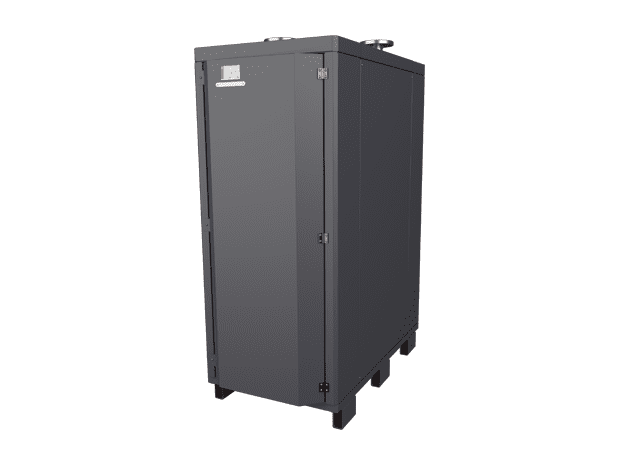Leading energy analysts, Element Energy (EE), conclude that networked heat pumps deployed at scale are up to 20% cheaper to run whilst costing 8% less upfront than Air Source Heat Pumps (for a longer-lasting, quieter and less visually impactful solution).
The new study by Element Energy used one of the most robust models of heat pump performance under real-life conditions, specifically taking into account British weather patterns, geology, topography and climate.
It is also the first study to provide real-world cost models for networked heat pump scenarios where the cost of the heat pump unit is separated from the cost of the ground array.
It concludes that networked heat pumps are the optimal solution, compared to air source heat pumps and central plant district heating, to meet the UK’s ambitious decarbonisation goals for the lowest overall cost, due to their superior performance and ability to be rolled out at scale in a way that mimics the existing gas grid.
Key takeaways:
- At scale, networked heat pumps have 20-25% lower annualised costs compared to an air source heat pump, with a lower upfront cost.
- Modelled specifically on the most common UK housing type, at scale deployment, upfront capital costs are roughly 8% (£900) lower, and annual running costs are 18% (£290/year) lower.
- Networked heat pumps offer customers ground source heat pumps for less than the price of an air source heat pump – with lower overall running costs.
Link to the full study here.
Below, Kensa Utilities Managing Director Wouter Thijssen explores some of the pioneering report’s key highlights, and what this can mean for the mass rollout of heat pumps.


Millions of households across the UK need to stop burning stuff
Heating the country’s buildings accounts for 23% of UK emissions – more than that of cars!
To reach net zero, all 28 million gas boilers installed in the UK’s households need to switch to low carbon heating, . That’s 20,000 a week between now and 2050!
Heat pumps are widely regarded as the front-running technology for decarbonising heat due to their exceptional proven efficiency. As we transition off gas it will be commonplace to see a heat pump per house, just as with a boiler per house today; this supports the UK government’s ambition for 600,000 heat pumps to be installed every year from 2028. For the densest areas in the UK, they’ll feed centrally-powered district heating networks, which will represent up to 20% of homes, according to the Climate Change Committee (CCC).
Ground source and air source heat pumps are the two leading forms of heat pumps. Given the scale of the challenge, both types will play a massive role in getting us to net zero.
The opportunities and challenges of ground source heat pumps
To date, air source heat pumps also the most common form of heat pump in the UK (but not in countries like Sweden or Germany, where ground source is most common – (Source: EHPA 2021 Market Report).
Ground source heat pumps are the most efficient. On a typical winter day with your heating on, a ground source heat pump takes in absorbed solar heat stored up to 300 metres underground at 8-12*C and feeds it to the heat pump. This means it does a lot less work to upgrade it to your 35-55C heating temperature than an air source heat pump that takes air in at 0C or less, making it a lot cheaper to run.Ground-source heat pumps typically achieve efficiencies over 400% (source: Evo TIS), whereas air-source deployments to date average 280% (Source: Energy Systems Catapult).
Being inside away from the elements means ground source heat pumps have fewer maintenance requirements, and also last much longer than air source heat pumps. Element Energy assumes an air source heat pump lasts 15 years and a ground source heat pump lasts 25 years.
So, ground source heat pumps are cheaper to run, require less maintenance, and have a longer life – what’s the catch? The two barriers that have always held back ground-source have been upfront cost and disruption: the extra upfront cost for putting in the ground arrays that gather that efficient heat from boreholes 150m – 300m underground, and the disruption of having the ground arrays installed.
The ground is the key to unlocking net zero with heat pumps
Think back to the gas network today. You do not pay upfront for the gas pipes in your street, nor do you have the disruption of putting them in yourself. A utility does this, and you pay a standing charge to access it. You just plug in your gas boiler.
Networked heat pumps emulate this for ground source heat pumps. A utility will fund and roll out this ground array infrastructure for your street, you just pay a standing charge to connect to it and access the free heat it absorbs. Now all you do is get a ground source heat pump for your house, which at scale will be cheaper than an air source heat pump (as the ground source heat pump doesn’t have additional components such as fans or extra equipment for external weatherproofing), and without the disruption of having to drill your own boreholes or dig trenches in your garden.
Two barriers removed. This is then a networked heat pump.
Networked heat pumps are the 21st-century equivalent of the gas grid. Ground arrays last over 100 years; they are buried, making them entirely unobtrusive. Boreholes can be linked together in a network that is scalable and perfectly suited to large-scale installations.
The Element Energy report confirms: “This model can be made commercially viable through economies of scale: designing and installing large-scale ground infrastructure to serve many properties simultaneously.” – EE pg 20
What used to be considered the most expensive heating system choice is now the cheapest. It also mimics the arrangements consumers are familiar with today through the gas network.
Proving networked heat pumps have lower overall costs
At scale, networked heat pumps have a 20% lower annualised cost compared to an air source heat pump, and a lower upfront cost, according to models by Element Energy.


3-bed Victorian terraced properties are the most common UK housing type – consuming 15,700kWh/yr. Upfront capital costs are roughly 8% (£900) lower, and annual running costs are 18% (£290/year) lower for scaled deployment of networked heat pumps. The latter is as the fuel costs and annualised capital expenditure is significantly lower for a ground source heat pump, which creates headroom to absorb the standing charge (to access the infrastructure in the street) while still ensuring a saving. The assumed cost advantages for networked heat pumps in this example can be broken down as follows:
- Fuel costs (covering the electricity bill to run the heat pumps): Lower due to the greater efficiency seen by ground source heat pumps
- Opex (cost of maintaining the heat pump): Assumed the same here as an air source heat pump, but real life installations evidence a ground source heat pump will be cheaper being inside and protected away from the elements
- Connection fee (the cost a heat pump user pays to access the ground array): Only seen here for the ground source heat pump
- Annualised capex (taking the cost of replacing the heat pump after its life and annualising it): Lower both due to the lower capex of the unit and the longer lifetime of ground source (20-25 years for ground source heat pump vs 15 years for air source heat pump)


The same drivers as above apply for the 3-bed newbuild case, where at scale upfront capital costs are 9% (£500) lower and running costs 16% (£115/year) lower.
This was based on hour-by-hour modelling of ground source heat pump and air source heat pump performance in British Weather (Leeds) and British building types (3-bed Victorian terrace & 3-bed newbuild). Combining this with data from the UK National Energy Efficiency Database (NEED), this is one of the most robust heat pump modelling studies on UK buildings to date.


Similar results are found in Aurora’s report – Decarbonisation of Heat in Great Britain, finding networked heat pumps costing less than air source heat pumps.
Modelling the coldest day of the year
Element Energy were also able to model the coldest day impact using the highly robust hour-by-hour modelling tool. This is crucial for determining the grid impact of heat pumps.
Based on 2010, the coldest winter in the past 20 years, we see the resilience of depending on stable below ground temperatures for our heating, rather than the air. While the ground will cool down in a colder winter, this effect isn’t nearly as pronounced as the cooling of the air. With these being the respective sources for ground source heat pumps and air source heat pumps, we see that air source heat pump running costs rise by £267/year whereas ground source heat pumps just £99/year.


This has significant grid implications, with upgrades needed to ensure the grid can meet peak demand. Aurora’s study mentioned above concluded that with networked ground source heat pumps you see a massive £40bn system cost savings to 2050 (relative to a more air source heat pump-heavy scenario), which ultimately trickles down to lower electricity bills once again.
Networked heat pumps are a key part of the jigsaw
We know that there is no silver bullet for decarbonising heating – different house types and regions will favour different solutions. We expect a mixture of individual air and ground source heat pumps, networked heat pumps and central-plant district heating to dominate the decarbonisation of heating. The key is to have an area-based approach (known as zoning), rather than a house-by-house approach, as each technology requires infrastructure deployment: grid upgrades especially for air source heat pumps, ground arrays for networked heat pumps, and district heating pipes for central plant district heating.
In theory, as networked heat pumps mimic the gas grid, they can work on 85% of UK homes currently on the gas grid. A Regen study similarly modelled 80% suitability. The sweet spot for networked heat pumps includes the two house types modelled above: terraced housing and newbuild, as well as flats and densely-distributed semi-detached homes. The University of Leeds did some great work illustrating this (here):


What is the best type of heating for different locations?
In city centres and the densest urban settings, central plant district heating is probably the favoured solution. For less densely populated areas an individual air or ground source heat pump is likely the favoured solution. Having a ground array connecting these more sparsely spread houses does limit the economies of scale benefit you get.
This leaves a gap in the middle: terraced streets, flats and densely-distributed semi-detached homes. These areas are likely not dense enough to warrant central plant district heating rolling out to it. Similarly, these areas often do not have the outdoor space to fit an individual air source (or individual ground source) heat pump:


The catch? This ‘middle’ represents circa 13 million UK households[1], 50% of the total! So what option is there to decarbonise heating in these houses? We believe that, as Element Energy’s modelling shows, networked heat pumps are the cheapest and best way to tackle these homes.
[1] Represents 6.93 million terraced houses and 6.10 million flats/maisonettes. Note this doesn’t include the 6.27 million semi-detached houses. Source: Table CTSOP3.0, Government Official Statistics on stock of properties







